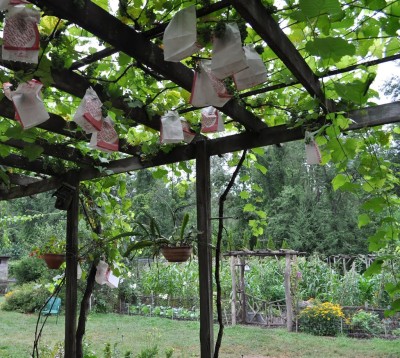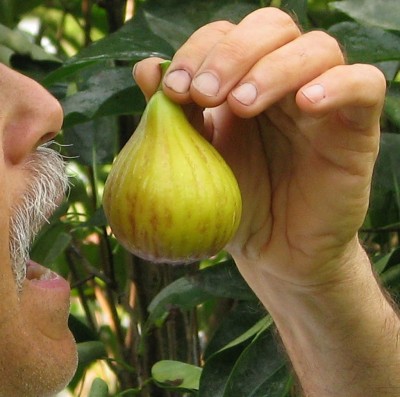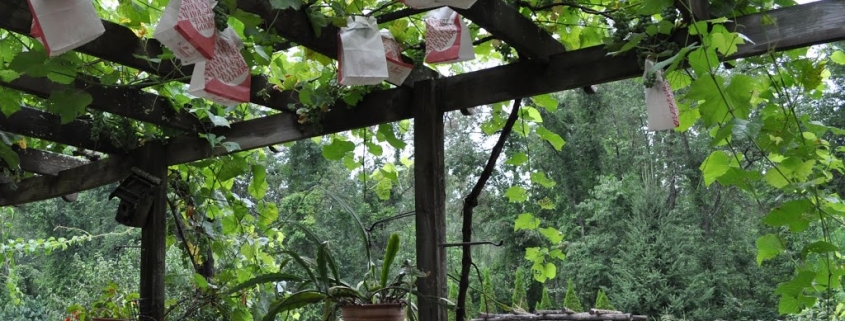[bagged grapes, squirrels, fig]
Almost everyone, upon taking their first step out my back door, glances upward and says, “What are those bags for?” They’re looking at my grape arbor from which dangle bunches of grapes as well as white paper bags. To me, the purpose of the bags is obvious: to enclose some of the bunches. Perhaps the fact that not all the grapes are bagged is confusing. Perhaps people are thrown off by the inscription “Fresh Delicious Wholesome Baked Goods” printed ini bold letters on the bags, which I bought in bulk from a bakery supplier.
Grapes are a luscious treat not only to us humans, but also to birds, bees, and some furry creatures. And disease organisms, such as black rot and powdery mildew, enjoy “eating” the berries as well as the leaves. The bags keep birds and furry creatures from eating the grapes or, at least, makes these creatures first figure out what is inside the bags and then work to get at the fruit. (I don’t think the bakery inscription throws them off.) The bags also keep the bunches dry and less susceptible to diseases that need moisture to flourish.

Bagging grapes fends off all these threats to let grape bunches be harvested when they are thoroughly ripe. And I mean thoroughly ripe, which is usually after the recommended harvest date for a particular variety. What a treat to tear open a bag to reveal a perfect bunch of grapes, dusted with their natural bloom, very sweet, and very rich in flavor! In autumn’s cool weather, ripe grapes hang in prime condition, bagged, for weeks.
Bag a bunch of grape by first making slits a couple of inches down each side of the open end of a paper bag. After snapping off the leaf or tendril opposite where a bunch attaches to the vine, a bag can be slipped up over a bunch and then its top folded back down over the stem and itself to seal out water and insects. Two staples, one on either side of the bag, hold it in place.
So why are aren’t all my grape bunches bagged? Because bagging all the bunches on the dozen different grape vines here would be too tedious a job. And anyway, not every unprotected bunch gets pilfered or diseased so we just eat the unbagged ones first.
******************************************
Squirrels seem to have receded back into the woods, and not because I played bagpipe music at them (which, I reported previously, was found to scare or otherwise keep rats away from tourists in Vienna’s historic sewers).
I still may resort to bagpipe music. For now, I have live traps ready, baited with peanuts and wired open for a few days so that any errant squirrels feel more at home wandering into them for a meal.
A few weeks ago, squirrels cleared green fruit from my one old apple tree, which was the one apple tree that did not get sprayed with Surround, a commercial clay product for organic insect control. Perhaps squirrels left my other trees alone because they don’t like the taste or feel of the clay. Just in case, today I gave all the trees still laden with apples another spray of Surround.
*******************************************
Today, July 20th, we ate our first ripe fig, a Green Ischia, picked from the greenhouse and almost the size of a tennis ball. Halving the fruit reveals a glistening deep red, juicy, sweet flesh.
This first fig is of the so-called breba crop, the crop that ripens on stems that grew last summer. My Green Ischia breba crop is always light because I had to cut back many of the stems late last fall, as I do every year, to keep the plants from overgrowing the greenhouse.

The main crop should start ripening in about a month, and fresh figs will continue ripening well into fall. Main crop figs form and ripen on new stems, a bearing habit that makes it easy to keep a fig tree from growing too large and makes it possible to harvest fruit well north of fig’s subtropical origins. All that’s needed is a season long enough and hot enough for new stems to grow, develop, and ripen fruit. The more drastically a plant is cut back (or freezes back), the longer the season needed to ripen fruit.
My other two varieties — Brown Turkey and Kadota — bear only main crop fruits. Their large crops of fruits, nearing ripeness soon, are different from each other and from Green Ischia, but are equally delicious.





Leave a Reply
Want to join the discussion?Feel free to contribute!